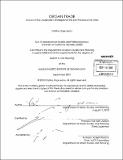| dc.contributor.advisor | Eran Ben-Joseph. | en_US |
| dc.contributor.author | Ungureanu, Cristina | en_US |
| dc.contributor.other | Massachusetts Institute of Technology. Dept. of Urban Studies and Planning. | en_US |
| dc.coverage.spatial | n-us-ca | en_US |
| dc.date.accessioned | 2011-04-04T16:25:21Z | |
| dc.date.available | 2011-04-04T16:25:21Z | |
| dc.date.copyright | 2010 | en_US |
| dc.date.issued | 2010 | en_US |
| dc.identifier.uri | http://hdl.handle.net/1721.1/62070 | |
| dc.description | Thesis (M.C.P.)--Massachusetts Institute of Technology, Dept. of Urban Studies and Planning, 2010. | en_US |
| dc.description | Cataloged from PDF version of thesis. | en_US |
| dc.description | Includes bibliographical references (p. 116-118). | en_US |
| dc.description.abstract | It is not only coastal conditions, but inland ones, that can inform an approach to and process of wetland adaptation in the face of sea level rise. A particular watershed clip in Alameda County, located in South San Francisco Bay, is taken as a test case in order to assess this hypothesis. The site is selected from a set of nested types of more general coastal and fluvial conditions. This thesis traverses multiple landscape scales in this way. The nested types include a coastal DNA structure, which reflects divergent watersheds draining to the Bay. These watershed types contain layered political boundaries, which themselves exhibit an array of differing hydrologic, demographic, economic and hardscape conditions. These conditions within conditions, reaching across scales, merit very particular treatments. Organ Trade contributes a new processing tool for wetland adaptation, beginning on the Bay Area's coasts, and reaching up through existing channels and streams where they exist. Even where fluvial availability is minimal, Organ Trade proposes a mechanism of dross acquisition in order to create a discontinuous but networked sponge-like layer for water retention. The thesis posits that inland riparian and hardscape management (inland infrastructure realignment - where infrastructure is taken to mean a broad array of items - that promotes fluvial enhancements and the creation of space for water retention) can help get the threatened coastal wetland system back in equilibrium. This thesis operates on the informed assumptions that (a) wetlands are organs of the Bay's anthropological and ecological order, (b) that these organs can be thought of as part of a closed system that functions maximally when in equilibrium, (c) that the system is threatened by an event external to itself, sea level rise, (d) that all elements essential to restoring equilibrium are and always have been within the system itself (hydrology, sediment, salinity, vegetation), and that (e) a calculated and transdisciplinary organ trade is a useful way of thinking about sea level rise adaptation in an urbanized estuary. This thesis begins to amass strategies that recreate the services, functions and values of threatened wetlands in an urbanized estuary. Wetland loss will be quantified most simply as the square kilometers of coastal wetlands inundated under 40cm and 140cm projections made by the Pacific Institute and the San Francisco Bay Conservation and Development Commission (BCDC). If wetlands cannot accrete quickly or efficiently enough to keep pace with sea level rise, this poses a serious threat to the ecological, cultural and economic wellbeing of the entire Bay. Additionally, because of the way the Bay Area has urbanized over time (creating a ring of thick, heavy infrastructure and human artefact only a short distance from the estuarine edge), almost no new wetlands can be created near coasts, and wetlands have little to no room to naturally migrate inland. Therefore, a compensatory trading system becomes a logical necessity, quantification for which is not within the scope of this thesis, but for which visioning and a systemic design approach can begin to be written about and shown graphically. Organ Trade offers a mapping methodology and set of tactics to make wetland trading decisions. | en_US |
| dc.description.statementofresponsibility | by Cristina Ungureanu. | en_US |
| dc.format.extent | 118 p. | en_US |
| dc.language.iso | eng | en_US |
| dc.publisher | Massachusetts Institute of Technology | en_US |
| dc.rights | M.I.T. theses are protected by
copyright. They may be viewed from this source for any purpose, but
reproduction or distribution in any format is prohibited without written
permission. See provided URL for inquiries about permission. | en_US |
| dc.rights.uri | http://dspace.mit.edu/handle/1721.1/7582 | en_US |
| dc.subject | Urban Studies and Planning. | en_US |
| dc.title | Organ Trade : sea level rise adaptation strategies for the San Francisco Bay Area | en_US |
| dc.type | Thesis | en_US |
| dc.description.degree | M.C.P. | en_US |
| dc.contributor.department | Massachusetts Institute of Technology. Department of Urban Studies and Planning | |
| dc.identifier.oclc | 708578406 | en_US |
